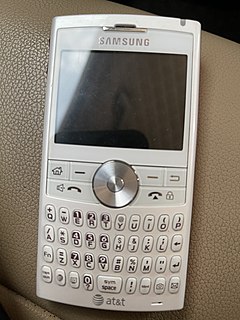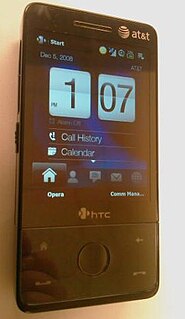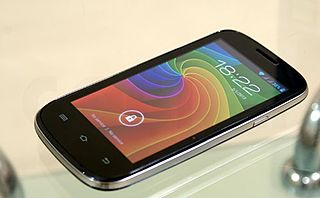Related Research Articles
The O2 Xda brand was a range of Windows Mobile PDA phones, marketed by O2, developed by O2 Asia and manufactured by multiple OEMs (mainly HTC, Quanta and Arima). The first model was released in June 2002. The last models came to market in 2008. The "X" represents convergence of voice and information/data within one product; the "DA" stands for "Digital Assistant", as in PDA. The name of XDA Developers is derived from it.

The Samsung BlackJack II, or Samsung SGH-i617, is a smartphone available through AT&T in the United States. It is the successor to the Samsung BlackJack. Canadian version, SGH-i616 is marketed as "Samsung Jack" by Rogers and Fido. The phone has since been succeeded by the Samsung Epix.

The Xperia X1 is a high-end smartphone from Sony Ericsson, and is the first in the manufacturer's Xperia series. The phone was designed and built by Taiwanese OEM HTC. The X1 was first presented at the 2008 Mobile World Congress.
The HTC Startrek is HTC's first clamshell smartphone. It is sold as the Qtek 8500, the Orange SPV F600, Dopod S300, the i-mate Smartflip, Cingular 3100, Cingular 3125, and the HTC S411 in Brazil.

The HTC Touch Pro is a smart phone from the Touch series of Internet-enabled Windows Mobile Pocket PC smartphones designed and marketed by HTC Corporation of Taiwan. It is an enhanced version of the HTC Touch Diamond with the addition of a left-side slide-out QWERTY keyboard, a microSD card slot, and a camera flash. The Touch Pro smartphone's functions include those of a camera phone and a portable media player in addition to text messaging and multimedia messaging. It also offers Internet services including e-mail, instant messaging, web browsing, and local Wi-Fi connectivity. Depending on its market, it is a quad-band GSM or quad-band UMTS phone with GPRS, EDGE, UMTS, HSDPA, and HSUPA or a tri-band CDMA phone with 1xEV-DO Rev A. All versions feature TouchFLO 3D — a new enhanced version of the TouchFLO interface, unique only to the latest Touch series. In March 2009, HTC announced a new version, the Touch Pro2 which has a larger screen (3.6") and a redesigned slide out QWERTY keyboard with spaces between the keys.

HTC Magic is an Android smartphone designed and manufactured by HTC. It is HTC's second Android phone after HTC Dream, HTC's first touch-only flagship Android device and the second Android phone commercially released, as well as the first Android phone without a keyboard.
The Samsung SGH-i907, marketed as the Samsung Epix in the United States by AT&T Wireless, is a Windows Mobile-based quad-band GSM smartphone manufactured by Samsung.

The Nexus S 4G is a smartphone co-developed by Google and Samsung and manufactured by Samsung Electronics for release in 2010. It was the first smartphone to use the Android 2.3 "Gingerbread" operating system, and the first Android device to support Near Field Communication (NFC) in both hardware and software.

The Samsung Galaxy Mini (GT-S5570[B/L/i]) is a smartphone manufactured by Samsung that runs the Android operating system. It was announced and released by Samsung in early 2011. In some markets it is known as Samsung Galaxy Next/Pop/NG, while it is sold in the United States as the Samsung Dart exclusively for T-Mobile. It is currently available in four different colors; steel grey, white, lime and orange. With this release the face buttons were changed to capacitive touch, matching the rest of the Galaxy lineup.

The HTC ChaCha is an Android smartphone that was announced by HTC in February 2011 at the Mobile World Congress, alongside its sister phone, the HTC Salsa.
Lenovo smartphones are marketed as the "LePhone" in Mainland China and the "IdeaPhone" overseas. Motorola Mobility, ZUK Mobile and Medion, divisions of Lenovo, sell smartphones under their own brands. As of September 2015, Lenovo is in the process of rebranding most of its phones using the Motorola brand name.

The HTC Salsa is an Android smartphone that was announced by HTC in June 2011 at the Mobile World Congress.

The Samsung Galaxy Note II is an Android phablet smartphone. Unveiled on August 29, 2012 and released in October 2012, the Galaxy Note II is a successor to the original Galaxy Note, incorporating improved stylus functionality, a larger 5.5-inch (140 mm) screen, and an updated hardware and casing design based on that of the Galaxy S III.
The Sony Xperia miro is a mid-range Android smartphone manufactured and developed by Sony Mobile Communications. The device was released globally during the third quarter of 2012. The device is available in colours black, pink, white with silver and white with gold. However, not all colours are available in all countries.
The following is a comparison of high-definition smartphone displays, containing information about their specific screen technology, resolution, size and pixel density. It is divided into three categories, containing smartphones with 720p, 1080p and 1440p displays.

The Acer Liquid E is a touchscreen smartphone developed and marketed by Acer Inc. It is the second handset designed by Acer that uses Android 2.1 (Eclair). It was introduced in February, 2010 succeeding the Acer Liquid A1.

The Micromax Ninja A89 is a dual SIM Android smartphone launched & marketed by Micromax Mobile. It was launched in February 2013 in India. The phone is now discontinued.
Lenovo A526 is a dual-SIM, quad-core MediaTek Cortex A7 based smartphone launched on 2 April 2014. It released on April 5, 2014.

The second-generation Moto G is an Android smartphone developed by Motorola Mobility. Released on September 6, 2014, it is a successor to the original Moto G released in 2013. The phone was initially aimed at developing markets, although it is also available in developed markets as a lower-cost option compared to other phones in its class.

The Samsung Wave Y, also known as the Samsung S5380 was announced in August 2011 and released later that year in November. It was marketed as a budget alternative to Samsung's higher-end Samsung Wave III. The phone initially sold for €90 (~$120).
References
- ↑ "Lenovo A820 - Full phone specifications". GSM Arena. Retrieved 26 July 2014.
- 1 2 3 4 5 6 7 8 o.o, gsmchoice com / PIK Sp z. "Lenovo A820 technical specifications :: GSMchoice.com". www.gsmchoice.com. Retrieved 2020-12-08.
- ↑ PhoneDB. "Lenovo IdeaPhone A820 / LePhone A820 | Device Specs | PhoneDB". phonedb.net. Retrieved 2020-12-08.
- ↑ "ROM Lenovo A820 | [Custom] add the 09/20/2013 on Needrom". www.needrom.com. Retrieved 2020-12-08.
- ↑ "Ultimate Lenovo A820 Review - Mobile Network Comparison" . Retrieved 2020-12-08.